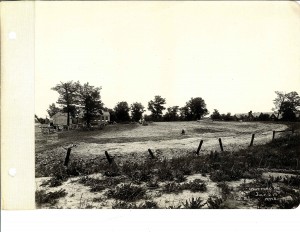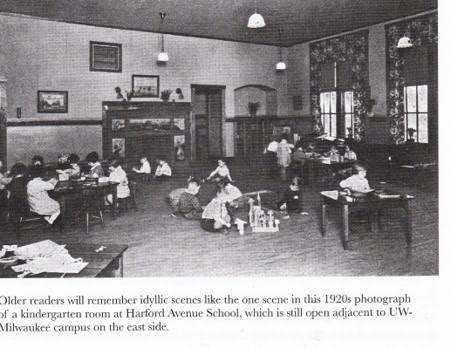by: Cynthia Sommer
Hartford Avenue University School (K4-8 grades) is celebrating its 100th year (1917-2017) as an anchor in the neighborhood and a gem in the city. Congratulations and thanks to the many teachers, parents, staff and students through the years who have contributed to the vibrancy and success of this school in our neighborhood.
 Hartford Avenue School was established in 1917 because of the rapid population growth of Milwaukee. In 1900, Milwaukee was ranked as the 14th largest U.S. city with a population of 285,315 and the City had become number 13 by 1920 with a population of 457,147. While the school was being built children were taught in four barracks in the middle of farm fields. The nearby buildings of the established Milwaukee Downer College could easily be seen to the north of the 3.03 acre plot. The school that opened in 1917 was 46,776 square feet at a cost for the grounds and building of $169,160. The main building that contained 12 classrooms was positioned on an angle facing the intersection of Hartford and Maryland Avenues. A small, separate boiler house and a chimney stack were also added at the back of the property.
Hartford Avenue School was established in 1917 because of the rapid population growth of Milwaukee. In 1900, Milwaukee was ranked as the 14th largest U.S. city with a population of 285,315 and the City had become number 13 by 1920 with a population of 457,147. While the school was being built children were taught in four barracks in the middle of farm fields. The nearby buildings of the established Milwaukee Downer College could easily be seen to the north of the 3.03 acre plot. The school that opened in 1917 was 46,776 square feet at a cost for the grounds and building of $169,160. The main building that contained 12 classrooms was positioned on an angle facing the intersection of Hartford and Maryland Avenues. A small, separate boiler house and a chimney stack were also added at the back of the property.
Enrollment increased rapidly as people moved into the neighborhood. Records indicate that there was an enrollment of 614 students in 1927—comparable to the current enrollment at Hartford Avenue University School of around 680 students. The need for more space was evident! In 1932, a 36,683 sq. ft. addition was completed behind and parallel to the current structure at a cost of $190,000. Four classrooms, a gymnasium and auditorium were provided by this addition. Current residents who have voted in previous government elections at the school may remember this “new” space as they walked on the well maintained but creaking wood floors of the gym. The building of the Hartford Avenue School addition was a real commitment by the School District because the depression created hard economic times. Teachers were asked to take a 10% pay cut in their salaries in 1932. In 1972, a small addition in the back was added for building maintenance. “is 85,700 sq. ft. building still serves the education of Milwaukee children to this date.
At the time of the establishment of Hartford Avenue School, the importance of reading, writing, arithmetic and spelling were evident in the curriculum, but education in Milwaukee was making progressive changes. In writing, the common sense free-hand movement approach to penmanship was adopted. In arithmetic, teachers would add practical problems relevant to the students’ lives and time into their lessons. For example, pupils were asked to calculate interest on bonds and war savings and compute the cost of transportation and supplies used in World War I. Memorization of a selected verse designated for each grade level was considered important to help students learn vocabulary and the flow of language.
Students would commonly recite such a verse when the Superintendent came for a routine visit to a school to evaluate their learning. In the three upper grades (6-8th), the socialized method of recitation was emphasized to encourage active learning and oral expression by the pupil. The subjects of the upper grades were starting to become specialized such that students would have their “home room” and then have certain subjects taught by advanced teachers in a special room such as a geography room or music room. This approach aided the teachers in the amount of their preparation, and an intensive study of a subject led to greater interest and concentration on the part of the student.
 Learning was affected not only by WWI but also by infectious diseases. Schools were closed at times because of the 1918 Influenza epidemic and by regular outbreaks of measles, whooping cough, and mumps. The Milwaukee School Tuberculosis Committee helped to established in 1917 a Nutrition Clinic to address the concern for the “large number of children suffering from the effects of insufficient nourishment.” Most students walked home for lunch but those involved in the MPS lunch program, first established in 1917, could get a “penny lunch” (price of lunch went up to 5 cents by 1940!).
Learning was affected not only by WWI but also by infectious diseases. Schools were closed at times because of the 1918 Influenza epidemic and by regular outbreaks of measles, whooping cough, and mumps. The Milwaukee School Tuberculosis Committee helped to established in 1917 a Nutrition Clinic to address the concern for the “large number of children suffering from the effects of insufficient nourishment.” Most students walked home for lunch but those involved in the MPS lunch program, first established in 1917, could get a “penny lunch” (price of lunch went up to 5 cents by 1940!).
The growth of the city and the economics of the time demanded concessions by all to insure the education of Milwaukee children. Through all these early years, the citizens of Milwaukee recognized the importance of education. Between the years 1906 and 1967, the voters approved 27 of the 29 requests for tax levying or bonding power to meet the cost of schools and their programs. Teachers were very dedicated individuals and in 1918 they only received a “flat annual salary with a minimum of $720 and a maximum of $1,500.” Salary increases were based solely on experience at the rate of $60 per year until the maximum was reached.
While the physical building at Hartford Avenue School has not changed much since those early years, many changes have subsequently occurred in education. The school has shifted from its early years as a neighborhood school to a college preparatory school. The unique location of this school in the heart of the UW-Milwaukee (UWM) campus provides a number of wonderful learning opportunities for preparing their students for college and beyond. Hartford maintains linkages with not only UWM but other colleges, businesses and professionals to enhance the academic success of their students. The emphasis on academics is augmented by a vibrant arts program and a focus on creating a sense of social justice. Extensive field trips, partnership with the Urban Ecology Center, Arts in Community Education (ACE), Danceworks, and Project Lead the Way engineering opportunities create unique learning experiences. Hartford maintains full-time art and music programs which is evident to anyone in the community who walks by the school and sees the display of creative student artwork.
Traditional subjects, including reading, writing, mathematics, science, social studies and the arts are taught to enhance critical thinking skills, creativity and an awareness of the real life issues of urban communities. Hartford Avenue University School was a Wisconsin Positive Behavior Intervention and Support (PBIS) School of Distinction and has implemented the Playworks program to coordinate playground activities to teach cooperation, teamwork and community building. The school will be developing this upcoming year a special educational program for grades 4-8 to better prepare and integrate their students for the top college bound urban high schools in the city. Hartford Avenue University School needs the support of the community to keep up the tradition of rich academics and vibrant arts—consider sharing your talents and energy by volunteering.
Murray Hill Neighborhood Association sends our sincere wishes to all in the Hartford School family for a successful 100th anniversary school year and years to come.
